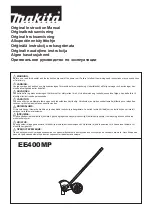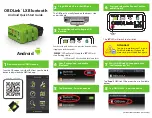
Scope / Multimeter
Tests and Capabilities (Quick Reference)
11
3.5 Tests and Capabilities (Quick
Reference)
The following chart identifies and describes available tests by function.
NOTE
Not all the tests listed are described in this manual. This list is intended as
reference only.
D
M
M
G
M
M
LS
Test
Function
a
Two Channel Lab
Scope
Displays two Lab Scope channels automatically.
a
Dual Graphing Meter
Displays two Graphing Multimeter channels
automatically.
a
Ignition Probe
Measures secondary Ignition voltage 2 to 50kV.
Displays secondary ignition (kV) waveforms.
a
a
a
Volts DC
Measures direct current voltage. DC voltage is
measured through the two test leads connected to
a DC circuit.
a
a
Volts DC - Average
Measures DC voltage using a filter to determine the
average voltage over a period in time. DC voltage is
measured through the two test leads connected to
a DC circuit.
a
a
Volts AC RMS
Measures the effective AC voltage, not the peak
voltage which results in measurements with higher
accuracy. The AC RMS (root mean square) voltage
value can be defined as the equivalent DC voltage
of the AC voltage measured. RMS values are
commonly used in AC electrical measurement, as
they are more representative of DC measurements.
a
a
Ohms
Measures electrical resistance (opposition to
current) 0 to 4 M Ohms. Scope supplied DC current
is passed through the circuit to measure the
resistance between the two connected test leads.
a
Diode/Continuity
Measures voltage drop across a diode and
continuity through a diode. Scope supplied DC
current is passed through the diode to measure the
voltage drop between the two connected test leads.
Typical setup for positive to negative current flow -
positive lead (anode +/side) and negative (cathode
-/side).
a
Frequency
Measures the number of times a signal repeats
itself per second. Used to measure frequency of
signals such as CKP, CMP and wheel speed
sensors.
a
Pulse Width
Measures the on-time of various components
(e.g. components that cycle on and off like the
EGR, or canister purge).
a
Injector Pulse Width
Measures fuel injector on-time when checking for
variances when engine load is changed and/or
physical problems with the injector.
a
Duty Cycle
Measures the ratio of the pulse width to the
complete cycle width, the on-time of components
that cycle on and off like EGR, or canister purge
from 0–100%.
a
a
a
Low Amps (20)
Used to measure amperage of typical devices (e.g.
ignition coils, injectors, fuel pumps) that may draw
up to 20A peak (startup) when initially started. Also
used to measure parasitic draw.
a
a
a
Low Amps (40)
Used to measure amperage of typical motors and
devices that may draw up to 40A peak (startup)
when initially started.
a
a
a
Low Amps (60)
Used to measure amperage of larger motors and
devices that may draw up to 60A peak (startup)
when initially started.
a
MC Dwell (60)
Measures carburetor Mixture Control Solenoids (0–
60°). The duty cycle of the solenoid is expressed in
the dwell angle of a 6 cylinder engine: 100% = 60
deg.
a
MC Dwell (90)
Measures fuel system Mixture Control Solenoids
(0–90°). The duty cycle of the solenoid is
expressed in the dwell angle of a 4 cylinder engine:
100% = 90 deg.
D
M
M
G
M
M
LS
Test
Function
















































